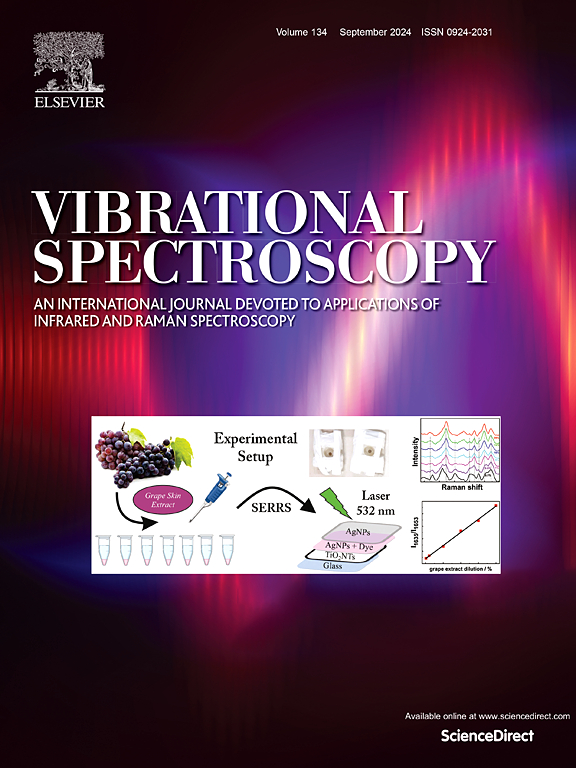基于增强小波包优化EEMD算法的频谱去噪方法
IF 3.1
3区 化学
Q2 CHEMISTRY, ANALYTICAL
引用次数: 0
摘要
地层流体中烃类气体的定量是利用测井地球物理技术对油气储层进行探测和评价的关键。然而,由于烷烃气体的异质性和广泛的浓度谱,再加上环境干扰,光谱数据往往充满了复杂性和噪声污染。这种普遍存在的噪声会显著地扭曲吸收光谱,从而影响烷烃气体定量的准确性。在保证红外光谱的信噪比和光谱分辨率的前提下,对采集到的红外光谱进行精确的去噪处理,这是一个迫切的挑战。本文提出了一种创新的红外光谱分析降噪方法,利用先进的小波包和优化的集成经验模态分解算法。该方法最初采用双变量相关分析来识别和隔离本征模态函数中的噪声成分。随后,利用噪声信号的样本熵与灰狼优化算法相结合,确定每个IMF分量的最有效阈值设置。该方法最终通过将小波包系数的样本熵与噪声的相关系数合成来确定阈值参数,从而根据每个小波系数的不同噪声属性定制阈值函数。实证结果表明,我们的方法优于传统的去噪技术,实现了优越的信噪比和分辨率,对特征峰的平均扰动小于0.3 %。本文章由计算机程序翻译,如有差异,请以英文原文为准。
Spectral denoising approach using enhanced wavelet packet-optimized EEMD algorithm
The quantification of hydrocarbon gases within formation fluids is paramount for the detection and evaluation of oil and gas reservoirs through well-logging geophysical techniques. Nonetheless, the spectral data are frequently fraught with complexity and noise contamination, attributable to the heterogeneous nature and extensive concentration spectrum of alkane gases, coupled with environmental interferences. This pervasive noise can markedly distort the absorption spectra, consequently compromising the accuracy of alkane gas quantification. The imperative challenge lies in the precise denoising of acquired infrared spectra while meticulously preserving the signal-to-noise ratio and spectral resolution. This present an innovative denoising methodology for infrared spectral analysis, leveraging an advanced wavelet packet coupled with an optimized Ensemble Empirical Mode Decomposition algorithm. This approach initially employs a bivariate correlation analysis to discern and isolate the noisy components within the Intrinsic Mode Functions. Subsequently, it harnesses the sample entropy of the noise signals in tandem with the Grey Wolf Optimization algorithm to ascertain the most efficacious threshold set for each IMF component. The methodology culminates in the formulation of threshold parameters through the synthesis of the sample entropy of wavelet packet coefficients with the correlation coefficients of the noise, thereby tailoring the threshold function to the distinct noise attributes of each wavelet coefficient. Empirical findings demonstrate that our approach outperforms conventional denoising techniques, achieving superior signal-to-noise ratios and resolution, with an average perturbation to characteristic peaks of less than 0.3 %.
求助全文
通过发布文献求助,成功后即可免费获取论文全文。
去求助
来源期刊

Vibrational Spectroscopy
化学-分析化学
CiteScore
4.70
自引率
4.00%
发文量
103
审稿时长
52 days
期刊介绍:
Vibrational Spectroscopy provides a vehicle for the publication of original research that focuses on vibrational spectroscopy. This covers infrared, near-infrared and Raman spectroscopies and publishes papers dealing with developments in applications, theory, techniques and instrumentation.
The topics covered by the journal include:
Sampling techniques,
Vibrational spectroscopy coupled with separation techniques,
Instrumentation (Fourier transform, conventional and laser based),
Data manipulation,
Spectra-structure correlation and group frequencies.
The application areas covered include:
Analytical chemistry,
Bio-organic and bio-inorganic chemistry,
Organic chemistry,
Inorganic chemistry,
Catalysis,
Environmental science,
Industrial chemistry,
Materials science,
Physical chemistry,
Polymer science,
Process control,
Specialized problem solving.
 求助内容:
求助内容: 应助结果提醒方式:
应助结果提醒方式:


